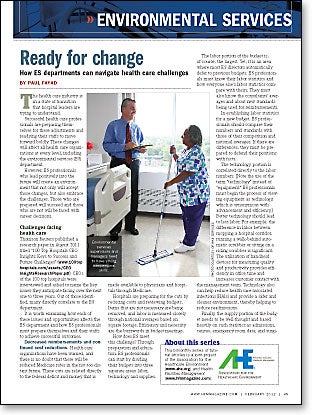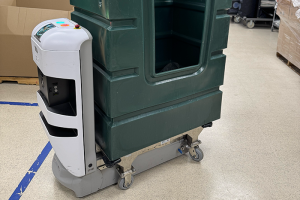Ready for change
 The health care industry is in a state of transition that hospital leaders are trying to understand.
The health care industry is in a state of transition that hospital leaders are trying to understand.
Successful health care professionals are preparing themselves for these adjustments and readying their staffs to move forward boldly. These changes will affect all health care organizations at every level, including the environmental services (ES) department.
However, ES professionals who lead positively into the future will create an environment that not only will accept those changes, but also embrace the challenges. Those who are prepared will succeed and those who are not will be faced with career decisions.
Challenges facing health care
Thomson Reuters published a research paper in August 2011 titled "100 Top Hospitals CEO Insights: Keys to Success and Future Challenges". CEOs of the 100 top hospitals were interviewed and asked to name the key issues they anticipate facing over the next one to three years. Out of those identified, many directly correlate to the ES department.
It is worth examining how each of these issues and opportunities affects the ES department and how ES professionals must prepare themselves and their staffs to achieve successful outcomes.
Decreased reimbursements and continued cost reductions. Health care organizations have been warned, and there is no doubt that there will be reduced Medicare rates in the not-too-distant future. These cuts are related directly to the federal deficit and money that is made available to physicians and hospitals through Medicare.
Hospitals are preparing for the cuts by reducing costs and reviewing budgets. Items that are not necessary are being removed, and labor is measured closely through national averages based on square footage. Efficiency and necessity are the buzzwords in budget meetings.
How does ES meet this challenge? Through preparation and education. ES professionals can start by dividing their budgets into three separate areas: labor, technology and supplies.
The labor portion of the budget is, of course, the largest. Yet, it is an area where most ES directors automatically defer to previous budgets. ES professionals must know their labor statistics and how everyone else's labor statistics compare with theirs. They must also know the consultants' averages and about new standards being used for reimbursements.
In establishing labor statistics for a new budget, ES professionals should compare their numbers and standards with those of their competition and national averages. If there are differences, they must be prepared to defend their positions with facts.
The technology portion is correlated directly to the labor numbers. [Note the use of the term "technology" instead of "equipment." ES professionals must begin the process of viewing equipment as technology, which is synonymous with advancement and efficiency.] Better technology should lead to less labor. For example, the difference in labor between mopping a hospital corridor, running a walk-behind automatic scrubber or sitting on a riding scrubber is significant. The utilization of handheld devices for measuring quality and productivity provides efficiency in office time and increases customer contact with the management team. Technology also can help reduce health care-associated infections (HAIs) and provide a safer and cleaner environment, thereby helping to reduce readmissions.
Finally, the supply portion of the budget needs to be well-thought and based heavily on such statistics as admissions, census, emergency room data, and surgical and outpatient activities. Moving to greener products helps facilities achieve sustainability goals. Using the correct germicides that are less caustic to surfaces leads to less work in maintaining those surfaces. ES professionals should be prepared to show that they are experts in all three of the budget areas.
Maintaining quality outcomes. Patients today are more informed. They can obtain information via the Internet on any hospital's quality outcomes at any time. Now, more than ever, the heat is on hospitals to provide high-quality, patient-centered care.
A national patient survey tool, the Hospital Consumer Assessment of Healthcare Providers and Systems (HCAHPS), is poised to reshape the way hospitals do business. "Everyone is looking for a silver bullet and HCAHPS is the closest thing we have," asserts Quint Studer, CEO of StuderGroup. "Raise HCAHPS scores and many other problems will fix themselves. This includes readmissions and HAIs, both of which are extremely costly to organizations."
HCAHPS is a national standardized survey tool used to measure adult inpatient perception of the quality of care they receive at an acute care hospital. Created in 2002, the 27-question survey is a combined effort of the Centers for Medicare & Medicaid Services and the Agency for Healthcare Research and Quality. Scores are publicly posted four times a year at www.hospitalcompare.hhs.gov.
Since 2007, most hospitals have been required to submit HCAHPS results to receive full Medicare payment. In the future, HCAHPS will play an even larger role in reimbursement. The Patient Protection and Affordable Care Act establishes a value-based purchasing plan beginning in fiscal 2013 (based on hospitals' performance in 2012 on measures that are part of the hospital quality reporting program). This will transition providers from HCAHPS pay-for-reporting to HCAHPS pay-for-performance.
The primary concern for ES departments always has been to provide a clean and safe environment. Today, the patients' perception is what determines success. How do ES professionals meet this challenge? Once again, through preparation and education. This involves educating the entire department, including all associates, on what is being measured. Provide literature and invite guest speakers to the associates' meetings to discuss HCAHPS and the measurement process. Post the scores and compare them with others and with national averages. Teach scripting and make certain that management staff follow up on complaints and issues no matter how small. Increased customer service scores increase positive HCAHPS scores.
Health care-associated infections. HAIs are developed in the health care environment. Such infections include fungal and bacterial infections and are aggravated by the reduced resistance of individual patients. Staphylococcus aureus, methicillin-resistant Staphylococcus aureus, Pseudomonas aeruginosa, Clostridium difficile and vancomycin-resistant enterococci are included on this list.
Knowing bacteria and fungi names is not enough. ES professionals must know their life cycles, how they are transmitted and how they can be controlled or killed. Proper training videos, one-on-one training, teaching about correct chemical usage and proper procedures are imperative.
New technology also is a factor. Surface inspection methods, such as adenosine triphosphate testing and phosphorus gels, help detect the presence of organic material that could support HAIs. Ultraviolet lighting systems are also available to aid in the elimination of HAIs. At minimum, the use of microfiber cloths and mops have proven to provide a cleaner surface than cotton rags and string mops.
ES professionals must know the differences of the available technologies and, most importantly, they must provide staff training and education on a continual basis.
Sustainability. Communities are looking at health care facilities to operate in an environmentally responsible and sustainable manner. By adapting sustainable practices, health care facilities help do their part within their communities and, in some cases, lead the charge to an overall sustainable environment.
This includes waste management, recycling, water management, air quality and construction, to name a few. Additionally, the Leadership in Energy and Environmental Design (LEED) building rating system — developed and administered by the U.S. Green Building Council, a Washington D.C.-based, nonprofit coalition of building industry leaders — was established to promote design and construction practices that increase profitability while reducing the negative environmental impacts of buildings and improving occupant health and well-being.
How do ES professionals meet this challenge? Also through preparation and education. Managers can become LEED-certified by taking classes offered throughout the country. Health care facilities can obtain LEED recognition by implementing such sustainable practices as reducing water consumption through sustainable landscaping and increasing recycling of materials like cardboard, plastic and batteries.
ES departments are taking the lead in many health care facilities when it comes to establishing sustainable practices.
Staff recruitment and retention. This is the most vital of all of the ES professional's issues and opportunities.
The recruiting and hiring process must focus on employees whose personalities reflect a strong desire to serve. Once such a hiring process is established, ES professionals then must be certain to provide strong, task-oriented skills development.
ES departments that fill positions based on skills alone tend to experience higher turnover and less job satisfaction. Supervisors and managers need to have strong interpersonal skills. They also need to develop relationships with their associates as well as with other departments. The focus is on developing positive work environments through positive leadership skills.
Meeting the challenges
ES professionals must do more with less and be prepared to prove and defend all decisions and choices they make. Most importantly, they need to surround themselves with strong managers, supervisors and associates.
It may seem daunting to manage an ES department, but staying focused on the positive, learning to embrace change and remembering that ES departments play an important role in the patient's healing process will help ES professionals meet these challenges.
Paul Fayad is CEO of HHA Services Inc., St. Clair Shores, Mich. He can be reached at pfayad@hhaservices.com.
| Sidebar - Five keys to ES department success |
| The art of war as defined by Sun Tzu in the classic book of the same name is governed by five constant factors, to be taken into account in one's deliberations when seeking to determine the conditions in the field. These five factors also can apply to successful environmental services (ES) operations: 1. The moral law. Within ES departments there must be trust and understanding that the decisions made by the management team are best for the department. This trust comes from transparency, continuous communication and the use of inquiry statements. 2. Heaven and the passage of time. The basis of health facility services involves providing a clean and safe environment 24 hours a day, 7 days a week, 365 days a year. ES professionals must be aware of what needs to be accomplished on each shift and during each season. Proactive planning is necessary for the entire year. 3. Earth. ES professionals must face many environmental and health care-associated infection challenges in trauma areas, surgical suites, labor and delivery suites, isolation rooms and other areas. 4. The commander. This represents the positive leadership skills that ES management teams must possess. The respect that ES professionals show to their associates and their ability to establish strong relationships creates a caring culture, which is necessary to be successful during times of uncertainty. 5. Method and discipline. In their roles as leaders, ES professionals must support the chain of command. Leaders who micromanage their departments do not create a respected management team and, in turn, do not succeed with succession management. If ES professionals divide responsibilities, provide the best supplies and the most advanced technologies, their departments will flourish. |



